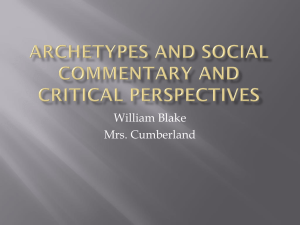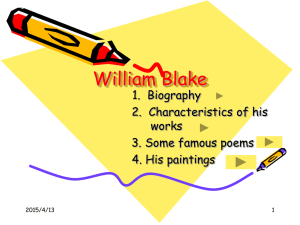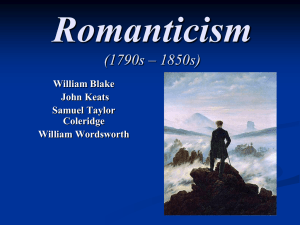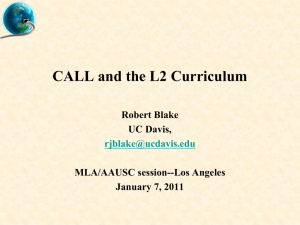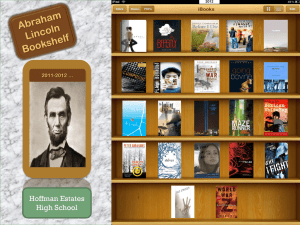Research Paper
advertisement
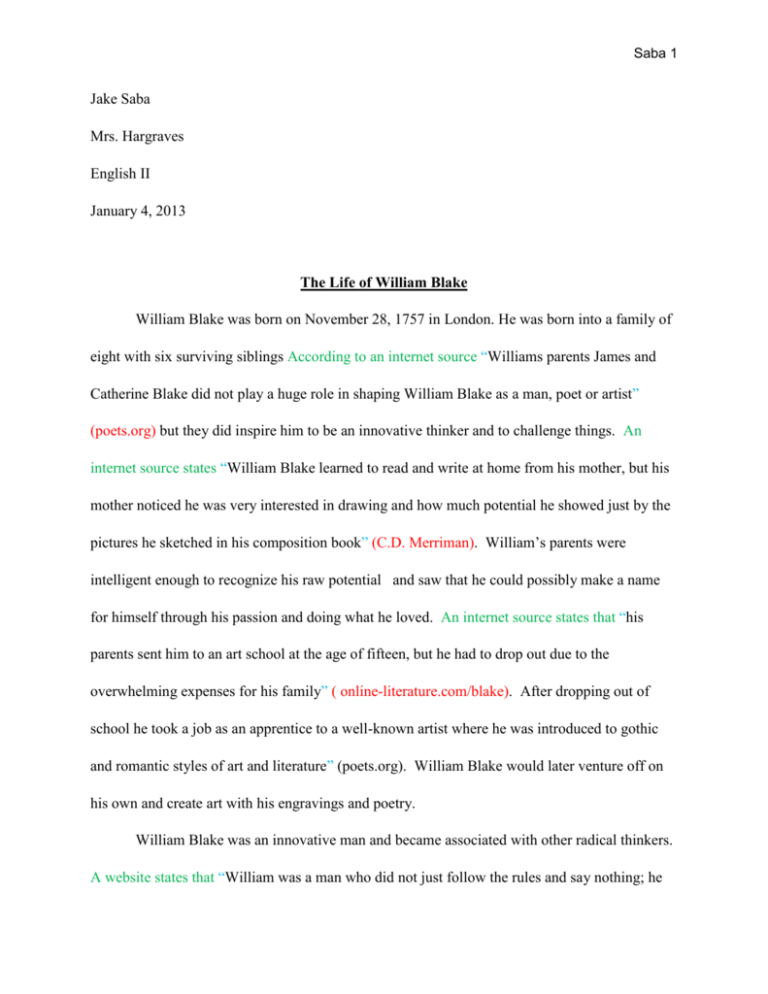
Saba 1 Jake Saba Mrs. Hargraves English II January 4, 2013 The Life of William Blake William Blake was born on November 28, 1757 in London. He was born into a family of eight with six surviving siblings According to an internet source “Williams parents James and Catherine Blake did not play a huge role in shaping William Blake as a man, poet or artist” (poets.org) but they did inspire him to be an innovative thinker and to challenge things. An internet source states “William Blake learned to read and write at home from his mother, but his mother noticed he was very interested in drawing and how much potential he showed just by the pictures he sketched in his composition book” (C.D. Merriman). William’s parents were intelligent enough to recognize his raw potential and saw that he could possibly make a name for himself through his passion and doing what he loved. An internet source states that “his parents sent him to an art school at the age of fifteen, but he had to drop out due to the overwhelming expenses for his family” ( online-literature.com/blake). After dropping out of school he took a job as an apprentice to a well-known artist where he was introduced to gothic and romantic styles of art and literature” (poets.org). William Blake would later venture off on his own and create art with his engravings and poetry. William Blake was an innovative man and became associated with other radical thinkers. A website states that “William was a man who did not just follow the rules and say nothing; he Saba 2 questioned things and tried to better them not only for himself, but for others” ( C.D. Merriman). William Blake’s writing style, paintings and engravings, although they were not orthodox, captured the hearts of millions across the world, by writing about what he saw in his mind and spirit, not necessarily what meant the eye. William Blake, although he is now well known, was highly unappreciated and not well recognized at his time, like most the other famous artists and writers of this period. William was very skilled and broke down barriers as a poet. As a young boy he did not grow upon a wealthyfamily. Blake’s Childhood was one of turbulence. William was one of six although 2 of his brothers died in infancy. According to an internet source, “Blake spoke of having visions— at four he saw God "put his head to the window"; around age nine, while walking dathrough the countryside, he saw a tree filled with angels.”(Poets.org). Obviously, this concerned William’s parents and they urged him to stop “lying about his encounters, but William tried to convince his parents theevents actually happened. After a couple months his parents would just dismiss the visions. They were concerned, however, about William actually acting out after these sightings. They began thinking about enrolling him in a more conventional school, which at the time was a school for the mentally unstable. Although they contemplated this, they decided to keep William at home for schooling which was very normal at the time. Furthermore, he did not act different around his peers after theses sightings. William learned to read and write from his parents, and then told them at age nine he wanted to be a painter. William’s parents then sent him to drawing school where he picked up his basics. A website states, “Two years later, Blake began writing poetry. When he turned fourteen, he apprenticed with an engraver because art school proved too costly.” (Poets.org). Saba 3 A biography by Blake says, “Working as an apprentice allowed William the necessary skill and experience he needed to become the William Blake who is admired around the world by many today.” ( Steve Blake). William worked as an apprentice for approximately seven years; these seven years shaped William not only as a poet and artist, but as a human being. These were pivotal years in Williams’s existence; he was introduced to Gothic styles of writing and painting as which he used in some of his later pieces of work. After his seven years of apprenticeship ended, William Blake briefly studied at the royal academy, a prestigious school in England for writers and artists. According to a website, “in 1782, he married an illiterate woman named Catherine Boucher. Blake taught her to read and to write, and also instructed her in draftsmanship.” (Poets.org). Williams wife , after she was taught to read and write by the hands of William Blake, helped to write some of his more famous poems. They remained married until death. They had no children, yet still lived a wonderful life together. William and his wife Catherine remained in England throughout their life and never ventured from the islands of the United Kingdom. In 1794, William started a print shop, which was a business that made signs and prints and certain other documents in bulk. William started this business with the help of his former apprentice and a friend by the name of James Parker. He worked there for the rest of his life, barely making enough to put food on the table for himself and his beautiful wife Catherine. As a side job William also engraved and illustrated books for well-known wealthy artists. He also wrote poetry. Although it was never appreciated while he was alive; he never stopped writing since it was something he loved to do . Writing, through his poems, helped him express himself as a human, and served as an outlet for all the stress he encountered because of his long Saba 4 job and financial difficulties. William began training his brother, Robert, in the art of engraving and printing in the winter of 1784. William’s brother unfortunately then fell ill and began slowly dying in front of the eyes, William Blake. An internet source says, “As Robert died, Blake saw his brother's spirit rise up through the ceiling, "clapping its hands for joy." He believed that Robert's spirit continued to visit him and later claimed that in a dream Robert taught him the printing method that he used in Songs of Innocence and other "illuminated" works.” (Daniel Craig). This played a crucial rule in William Blake becoming the famed and storied poet and illustrator we know today. Without these visions William’s most famous body of work “Songs of Innocence” could have been very different. If he never had these visions William Blake could may have just been another average printer that never amount to anything more than just an average working man in the late 1700’s and early 1800’s. According to a valid internet source, “ William Blake was one of England’s greatest poets. He combined a lofty mysticism, imagination and vision with an uncompromising awareness of the harsh realities of life.” ( Daniel Craig ). This quote proves that without the visions William Blake received as a young boy of God and angels, his life and writings would have been very different. God is evident in all of William’s poetry. Behind all of William Blake’s poetry is the theme of dust returning to dust, dirt returning to dirt. It is about human beings returning to what we began as, dirt and dust. God made us from dirt in the first account of genesis or the story of creation, which many believe William Blake is trying to mimic through many of his poems. This theme is most evident in his most famous work, “Songs of Innocence”. Saba 5 William Blake states, “To see the world in a grain of sand, and to see heaven in a wild flower, hold infinity in the palm of your hands, and eternity in an hour.” ( William Blake pg. 1). I use this quote because it embodies William Blake’s work at large. It shows how he used vivid language to keep the readers imagination active. The quote shows how God plays a rule in all of his writing. It also shows how he used nature in all of his writings to convey his messages. It also tells us how something so small is still God’s creation and we must appreciate everything around us. Everything is connected and flows together to give us balance. William Blake’s writings were often about something simple, a schoolboy, a flower or tiger. He used simple things like these to embody a much larger and deeper message. William was a truly one of a kind poet. He was a romanticist and focused heavily on being a romanticist. Being a romanticist meant that he focused on detail and the deeper meaning of things. He wrote about not what meant the eye, but what meant the mind. He would see a mountain and not just write something about the mountain, he would take the mountain and focus on its deeper meaning. He would focus on why God put it there, its meaning to the world and what he thought the mountain symbolized as a whole. Being a romanticist also meant that he focused on nature and not always material things, but things such as heaven and hell, dreams and visions, and other non-materialistic type things. With William it was not what meant the eye, but what meant the mind and spirit. This is why William Blake’s work is revered throughout the whole world. This is why William Blake’s work has with stood the hardest test of all, time. William Blake was in fact one of not only England’s greatest poets, but one of the greatest poets the world has ever offered to us. Saba 6 Works Cited Blake, Steve. "Biography William Blake." William Blake Biography. Apples, 9 Apr. 2001. Web. 24 Feb. 2013. Blake, William. Songs of Innocence and Experience. Mount Vernon [N.Y.: Peter Pauper, 1937. Print. Craig, Daniel. "William Blake." Goodreads. GoodReads, 27 Dec. 2007. Web. 24 Feb. 2013. Meriman, C.D. "William Blake." - Biography and Works. Search Texts, Read Online. Discuss. N.p., 12 Oct. 2010. Web. 22 Feb. 2013. Williams, Bobby. "William Blake." Poets.org. Poets United, 8 Mar. 2005. Web. 22 Feb. 2013.
